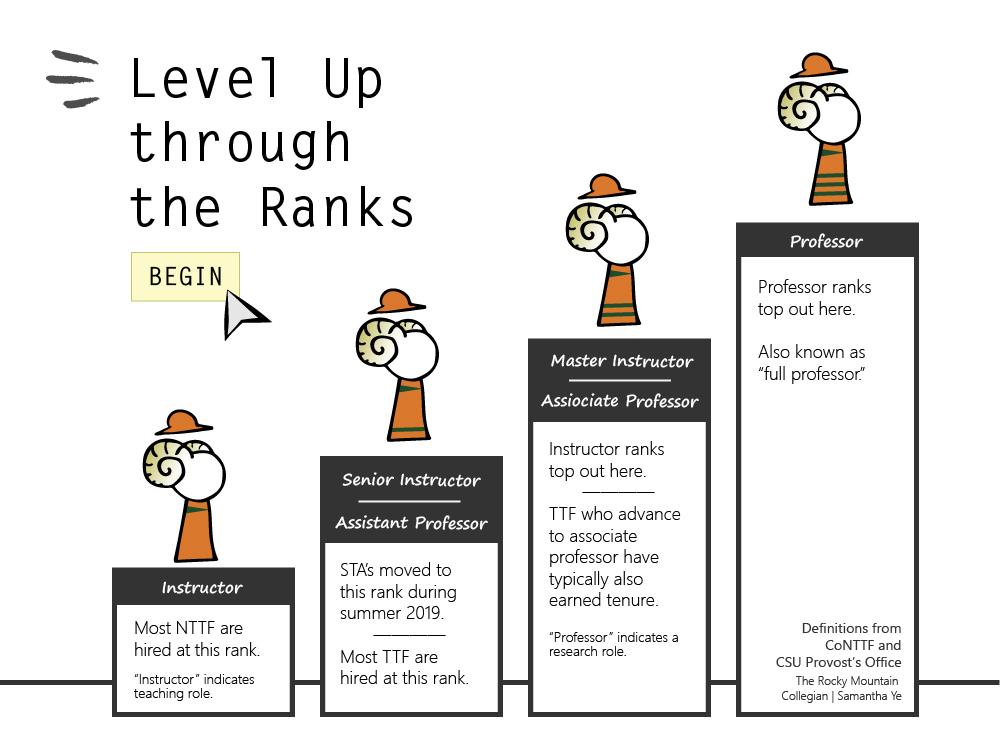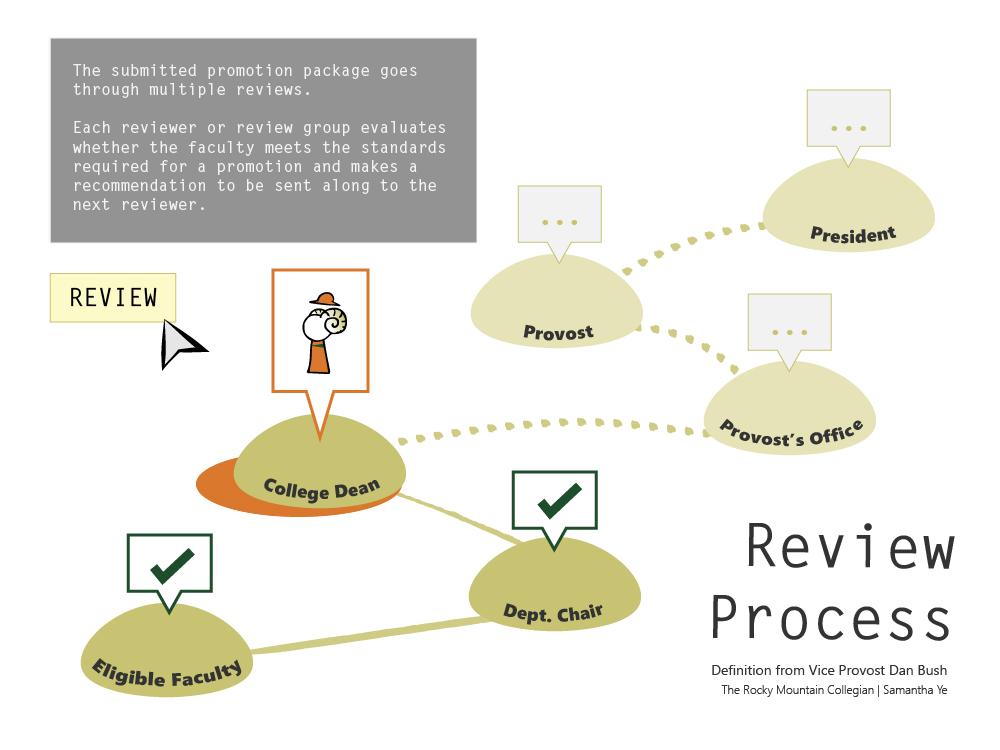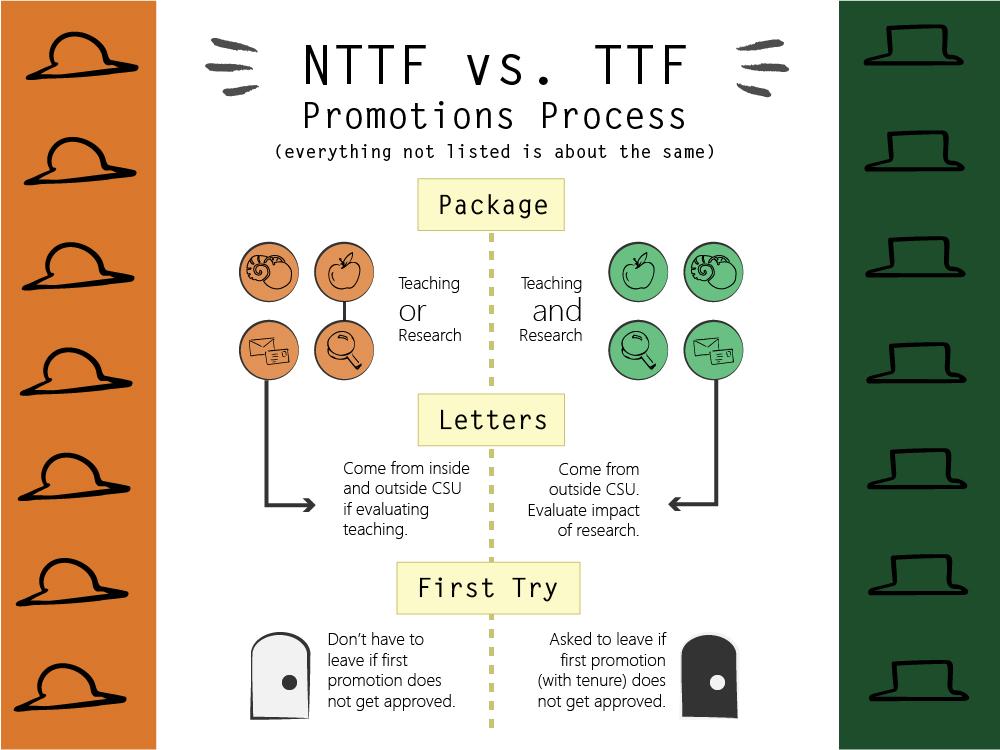Editor’s Note: This is the final article within a five-part series regarding NTTF at Colorado State University, going into a week in which NTTF will be heavily discussed. See Part 1: A student’s guide to your professor’s career | Part 2: The question of compensation | Part 3: Fortifying faculty appointment types | Part 5: The Future of Faculty
Even more daunting than the redefining of faculty types is the opening of new faculty ranks.
If appointment types are like the character class, ranks are the experience levels, which Colorado State University faculty reach by obtaining rigorously evaluated promotions.
All promotions come with a 10% raise. For non-tenure track faculty with a terminal degree, that raise will be on top of the new floor salary of $45,000.
Up until now, many NTTF were excluded from any promotional pathways either because of a lack of promotional systems for them or ineligibility rooted in the different college codes, such as degree requirements.
The ranks were also limited to professorial roles: assistant professor, associate professor and professor.
Some colleges did promote NTTF through professor ranks, namely the College of Health and Human Sciences and the Veterinary College, according to Dan Bush, vice provost for faculty.
For other colleges, like the College of Liberal Arts, NTTF could apply to become a senior teaching appointment, which was an appointment type, not a rank. 
Applying for an STA had a similar process as applying for a promotion but was not a real promotion. It was meant to recognize outstanding NTTF work and sometimes came with a 5% pay raise.
The remaining NTTF had no way of being promoted.
To address the issue, all 52 CSU departments have since written two new ranks into the books: senior instructor and master instructor. These build on the lowest “instructor” rank most NTTF are hired at.
While the new instructor ranks are not limited to NTTF — a TTF who focuses more on teaching could decide to take up an instructor rank, for example — their addition, paired with revisions to department codes, should give NTTF who were previously excluded pathways to promotions. Ranks on the same level otherwise hold the same status, Bush said.
Over the summer, STAs were automatically promoted to the senior instructor rank, having gone through a promotion-like process already, and given a 10% or 5% raise if they received a partial raise before.
For other NTTF, the promotion process will look quite similar to what TTF go through.
How do you get promoted?
To be eligible for a promotion, a faculty member has to have been in their current rank for at least five years.
So, for NTTF who have been at CSU perhaps for 10 years, they can not jump two promotions at once; they have to wait five years between applying. For ex-STAs, the clock started this summer, when they became senior instructors with some potential for reduced wait time.
When wishing to initiate a promotion review, all eligible faculty start by compiling a “promotion package.”
For TTF, packages contain information about the individual’s teaching, research and service work at CSU as well as a set of “outside letters.”
Outside letters are reviews of the faculty member’s work solicited from scholars at other institutions who work in the same field as them. They provide an “independent voice” on the TTF’s work, Bush said, so the University can better gauge the scholarly impact they are making in their field, which may not necessarily be reflected within the scope of CSU.
After the package is compiled, it is reviewed by a whole list of people in the following order:
- All the eligible faculty of the faculty member’s department (Requirements vary, but all voting faculty must be at a higher rank than the faculty member under consideration. For promotion of a tenured or TTF member, only tenured committee members are voting members. NTTF and TTF can vote on the promotion of a NTTF member, however.)
- The department chair
- The college dean and their promotion committee (typically consisting of all the college’s department chairs)
- The Provost’s Office
- The Provost (currently Rick Miranda)
- The University President (currently Joyce McConnell)
Every group or person in the process makes a recommendation of whether or not they think the applicant meets the criteria for promotion, which varies by department code.
The person who actually decides if they meet it is CSU President Joyce McConnell. She will review the package and previous recommendations to decide if the promotion is granted.
Because McConnell opened up promotions for all 285 eligible NTTF in August, she is tasked with reviewing potentially hundreds of recommendations and their packages this year, worth about $1.75 million in salary increases.
According to Bush, promotions follow a strict review process, which begins in the fall and ends with a final decision in the spring. All college promotion packages will be submitted to the Provost’s Office by Feb. 14, 2020.
How will NTTF promotions differ?
Promotions processes for NTTF will run almost identical to TTF, right down to using many of the same documents, Bush said.
“It’s a pretty thorough process,” Bush said. “It’s a thoughtful way to review people; it helps us be consistent.”
The main difference will go back to the hired role of NTTF, which is either research or teaching. Rather than filling out both sections like TTF, NTTF only have to do one, because that is what they are evaluated on, as well as the service section.
TTF also must get their first promotion from the assistant to associate professor rank and obtain tenure after six years. Otherwise, they will leave the University.
If an NTTF does not get their first promotion, they may receive some support for improvement and try again.
McConnell, Bush and Provost Rick Miranda wrote that since “promotion to the new ranks is a new possibility at CSU, not all NTT faculty may have been addressing the activities and professional development necessary to meet the criteria for successful promotion to the next rank. Thus, even with many years of service, it may take additional time for some faculty to meet the criteria for promotion to the next rank.”
As for the outside letters, CSU is piloting a new process for teaching-based NTTF.
According to a document sent out by McConnell from the Provost’s Office, NTTF are required to submit at least two letters of reference from higher education faculty outside of CSU to gauge the NTTF’s teaching work. Three other letters will come from faculty at CSU outside the applicant’s academic department.
Outside review of teaching is a bit trickier and will require some time to develop, Bush said. But, hopefully, the outcome will be having more refined ways to evaluate teaching quality.
Though for Jenny Morse, chair of the Committee on NTTF, the current process is another example of ongoing faculty iniquity.
“External review of paper just doesn’t make sense as a basis for the promotion of teaching faculty, especially when those faculty haven’t had the same opportunities to develop external reputations as our tenure-line faculty have,” Morse wrote in an email to The Collegian.
While some NTTF conduct research and publish articles, it is not considered part of their job, Morse wrote. Only in May were NTTF given the option to apply for paid professional development time so they could work on those kinds of projects. As such, their outside impact is limited, and teaching portfolios are unlikely to capture their impact in the classroom.
Morse wrote CoNTTF believes faculty should be evaluated in a way that makes sense for teaching, such as a review from organizations like The Institute for Learning and Teaching.
“I believe that if you want to know if someone is a good teacher, you have to see them in action,” Morse wrote.
Samantha Ye can be reached at news@collegian.com or on Twitter @samxye4.














